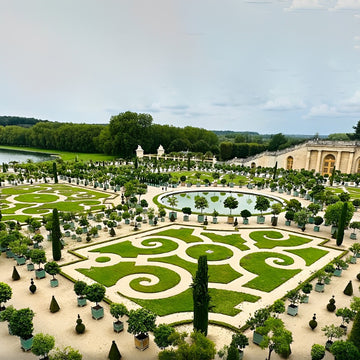The fine summer weather heralds the return of unique musical fountain evenings to celebrate the splendid musical unique gardens created by the Sun King.
Planted by Le Nôtre, a genius regarded as the father of fine gardening, the details of these gardens are as pleasant as they are diverse: the waters produce most admirable effects and masterpieces of sculpture abound”, wrote Dezallier d’Argenville in his 1768 book, Voyage aux Environs de Paris. Sneakers, jeans and caps may have replaced ribboned shœs, brocades and wigs, but the Palace’s beauty, praised by the 18th-century theoretician of classical gardens remains just as it was, offering the perfect setting for the annual Musical Fountains festival. Every day until October 29, the fountains, basins, waterfalls, water alleys, caves and nymphaeum come to life to present visitors from around the world with the same magnificent spectacle imagined by Louis XIV when he built the palace with its water displays evoking the seasons, and Nymphs' Bath and Dragon fountains.
A walk designed by Louis XIV
Every day, king and his court would gather in the garden to take refreshment, listen to music and also to dance. These open-air salons allowed Louis XIV to satisfy his passions for games and fine spectacle. As Nicolas Hustache, of Château de Versailles Spectacles, explains: “Louis XIV created his legend with the château’s gardens and passages, which he never stopped building throughout his reign. With the emblematic Apollo (currently under restoration) springing from the waters and Neptune unleashing storms, the sovereign fashioned his greatness with Greek mythology, which also created a truly unique place”. Given that foreign ambassadors of the time were dazzled by so much magnificence, the king took it upon himself to act as their guide on an extraordinary walk, which visitors can still discover today, personally designing an itinerary punctuated by ‘water effects. “Upon leaving the Palace by the vestibule of the Cour de Marbre, visitors should mount the wide terrace with stops at the top of the stairs to admire the ornamental water basins and the Fontaines des Cabinets (now known as the Fontaine du Point du Jour and Fontaine du Soir)”.
Orchestrating all of this enchantment, the palace's 13 fountain workers, continue to maintain these extraordinary waterworks with expertise passed down from Louis XIV’s craftsmen. According to Gilles Bultez, head of the palace's water and fountains team, “They keep water flowing through the system and maintain the 21-mi (35-km) network of pipes, 80% of which dates from the time of Louis XIV. Some of these pipes are made of lead, which has to be maintained using 17th-century crafts, like ladle welding.” The technique involves heating tin to more than 600° F (300° C), before pouring it onto the pipes to ensure they are watertight. From the garden’s inception, “supplying it with water has been a complex task. Versailles is not close to any river, and is more than 330 feet (100 meters) above the Seine. The flow of water still depends on the power of gravity, just as it did under Louis XIV ”, points out Bultez. To further understand the complexity of the water supply system he takes us behind the scenes under the sumptuous Latona Fountain. Alternating fountain jets Ducking down so as not to bump our heads, we enter a narrow gallery five feet (1.50 meters) below visitors’ feet, the lair of an enormous octopus whose tentacles feed the fountain with water. Having been entirely dismantled and meticulously restored, it is ready to last another 300 years. For fountains like the Latona, “water is stored in high basins and gradually reaches the Grand Canal passing through several other fountains that are also powered by the same gravitional force”. To avoid wasting water, modern machinery is used to pump it from the Grand Canal back up to the Montbauron reservoir. The complexity of the system explains why the fountains cannot operate continuously. Under the Sun King’, a day of open fountains required 2.5 million cubic feet (72,000 cubic meters) of water. Even then, it was only turned on shortly in advance of the monarch’s arrival. For the Muscial Fountains Show, fountain workers equipped with walkie-talkies open the valves in perfect time to the music, just like their forebears of the last 300 years.
Celebrating Baroque music
The show is a technical and an artistic triumph: the fountains send water dancing high into the sky, creating jets, plumes, bubbles and cascades, which make the coloured rocks and elegant statues shimmer. The Grandes Eaux is also a musical spectacle in itself that adds to the charm of works by the great Baroque composers – Lully, Charpentier, Rameau – which accompanied the royal stroll. This year's musical extravaganza has been designed by Laurent Brunner, Director of Château de Versailles Spectacles, who also manages the palace’s magnificent Royal Opera House, the Royal Chapel and the Royal Serenade in the Hall of Mirrors. At nightfall, all the splendours of the gardens are set in motion for the Musical Fountains Show, when the groves, fountains and ponds are flooded with light and water to the sound of Baroque music and a magnificent fireworks display befitting of a royal walk illuminates the skies. Good to know
The Château de Versailles Musical Fountain Shows are set to run on Saturdays and Sundays until October 29.
Two ticket types: passport tickets (€28.50) allow visitors access to the entire domaine including the palace, while Musical Fountain Show tickets (€10.50) restrict access to the gardens.
For more details, visit chateauversailles.fr


